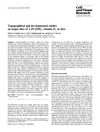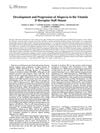Vitamin D Receptor Ablation Alters Skin Architecture and Homeostasis of Dendritic Epidermal T Cells
February 2005
in “
British journal of dermatology/British journal of dermatology, Supplement
”
TLDR Lack of Vitamin D receptor changes skin structure and increases certain immune cells in the skin.
The study investigated the effects of Vitamin D receptor (VDR) deficiency on skin physiology by examining the structural, phenotypic, and functional properties of skin and skin leukocyte populations in VDR knockout (VDR–/–) mice. The absence of VDR led to a range of skin pathologies, including increased dermal collagen, enlarged sebaceous glands, dilated hair follicles, epidermal cysts, a higher number of dendritic epidermal T cells (DETC), and hyperkeratosis, with these conditions worsening with age. However, Langerhans cells (LC) appeared unaffected in terms of distribution, morphology, and number. In vitro experiments showed that 1,25(OH)2D3, the active form of vitamin D, inhibited LC maturation and T-cell stimulatory capacity in VDR+/+ mice but not in VDR–/– mice, indicating that LC are targets of vitamin D3 and that VDR is necessary for the immunosuppressive effects of vitamin D3 on LC. The study concluded that VDR is crucial for controlling dermal collagen production, hair development and growth, sebaceous gland proliferation, and DETC homeostasis, while VDR deficiency does not impact LC phenotype and function.








